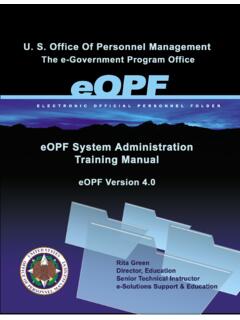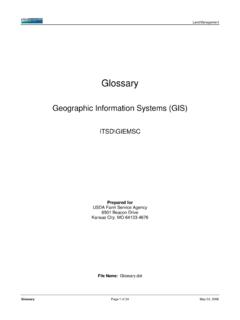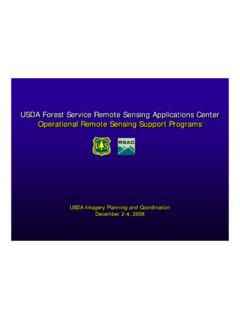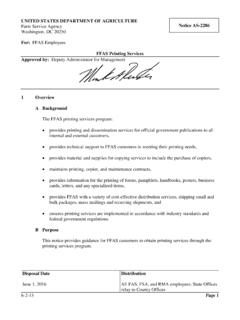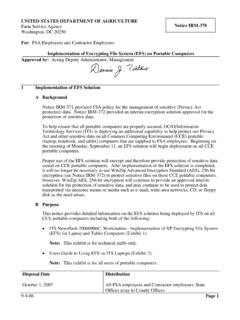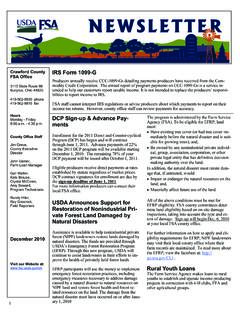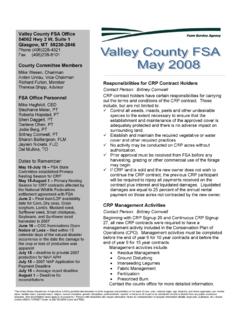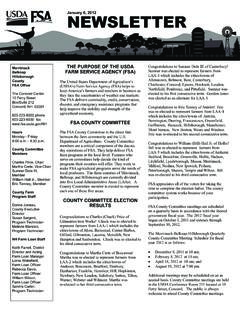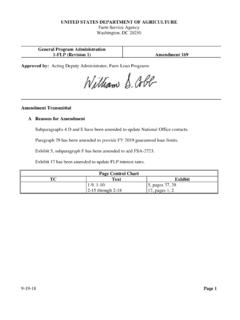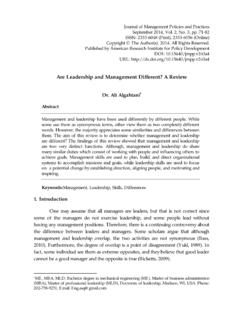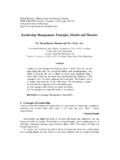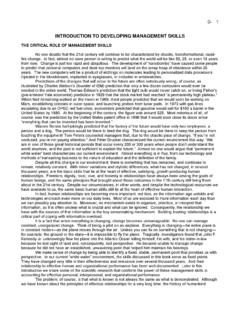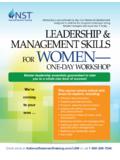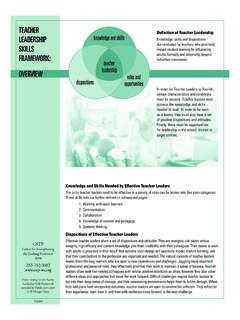Transcription of Leadership Core Competencies - Farm Service Agency
1 Leadership core Competencies The 28 Leadership core Competencies are divided into five levels. Definitions are listed below organized by the Leadership levels. Managing Self Integrity/Honesty: Behaves in an honest, fair, and ethical manner. Shows consistency in words and actions. Models high standards of ethics. Interpersonal skills : Treats others with courtesy, sensitivity, and respect. Considers and responds appropriately to the needs and feelings of different people in different situations. Continual Learning: Assesses and recognizes own strengths and weaknesses; pursues self-development.
2 Resilience: Deals effectively with pressure; remains optimistic and persistent, even under adversity. Recovers quickly from setbacks. Oral Communication: Makes clear and convincing oral presentations. Listens effectively; clarifies information as needed. Written Communication: Writes in a clear, concise, organized, and convincing manner for the intended audience. Flexibility: Is open to change and new information; rapidly adapts to new information, changing conditions, or unexpected obstacles. Problem Solving: Identifies and analyzes problems; weighs relevance and accuracy of information; generates and evaluates alternative solutions; makes recommendations.
3 1 Managing Projects Team Building: Inspires and fosters team commitment, spirit, pride, and trust. Facilitates cooperation and motivates team members to accomplish group goals. Customer Service : Anticipates and meets the needs of both internal and external customers. Delivers high-quality products and services ; is committed to continuous improvement. Technical Credibility: Understands and appropriately applies principles, procedures, requirements, regulations, and policies related to specialized expertise. Accountability: Holds self and others accountable for measurable high-quality, timely, and cost effective results.
4 Determines objectives, sets priorities, and delegates work. Accepts responsibility for mistakes. Complies with established control systems and rules. Decisiveness: Makes well-informed, effective, and timely decisions, even when data are limited or solutions produce unpleasant consequences; perceives the impact and implications of decisions. Influencing / Negotiating: Persuades others; builds consensus through give and take; gains cooperation from others to obtain information and accomplish goals. Managing People Human Capital management : Builds and manages workforce based on organizational goals, budget considerations, and staffing needs.
5 Ensures employees are appropriately recruited, selected, appraised, and rewarded; takes action to address performance problems. Manages a multi-sector workforce and a variety of work situations. Leveraging Diversity: Fosters an inclusive workplace where diversity and individual differences are valued and leveraged to achieve the vision and mission of the organization. Conflict management : Encourages creative tension and differences of opinions. Anticipates and takes steps to prevent counter-productive confrontations. Manages and resolves conflicts and disagreements in a constructive manner.
6 Public Service Motivation: Shows a commitment to serve the public. Ensures that actions meet public needs; aligns organizational objectives and practices with public interests. Developing Others: Develops the ability of others to perform and contribute to the organization by providing ongoing feedback and by providing opportunities to learn through formal and informal methods 2 3 Managing Programs Technology management : Keeps up-to-date on technological developments. Makes effective use of technology to achieve results. Ensures access to, and security of, technology systems.
7 Financial management : Understands the organization s financial processes. Prepares, justifies, and administers the program budget. Oversees procurement and contracting to achieve desired results. Monitors expenditures and uses cost-benefit thinking to set priorities. Creativity / Innovation: Develops new insights into situations; questions conventional approaches; encourages new ideas and innovations; designs and implements new or cutting edge Partnering: Develops networks and builds alliances; collaborates across boundaries to build strategic relationships and achieve common goals.
8 Political Savvy: Identifies the internal and external politics that impact the work of the organization. Perceives organizational and political reality and acts accordingly. Leading Organizations External Awareness: Understands and keeps up-to-date on local, national, and international policies and trends that affect the organization and shape stakeholders views; is aware of the organization s impact on the external Vision: Takes a long-term view and builds a shared vision with others; acts as a catalyst for organization change. Influences others to translate vision into action.
9 Strategic Thinking: Formulates objectives and priorities, and implements plans consistent with the long-term interest of the organization in a global environment, Capitalizes on opportunities and manages risks. Entrepreneurship: Positions the organization for future success by identifying new opportunities; builds the organization by developing or improving products or services . Takes calculated risks to accomplish organizational objectives.
